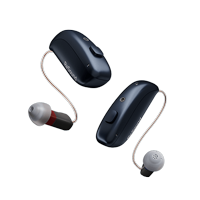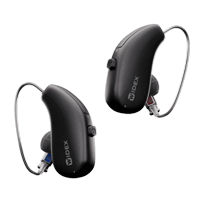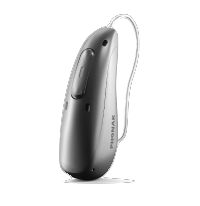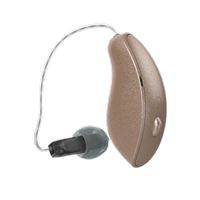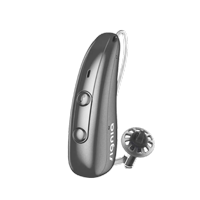When it comes to choosing the right hearing aid, understanding the different styles available is crucial for making an informed decision. The hearing aid market has evolved significantly over the years, offering various options to suit different needs, preferences, and degrees of hearing loss. Let’s explore the most common hearing aid styles in today’s market and what makes each one unique.
Behind-the-Ear (BTE): The Market Leader
The Behind-the-Ear (BTE) hearing aid is currently the most common and popular hearing aid style in the market. These devices sit comfortably behind the ear and are connected to an earmold or dome that fits inside the ear canal. BTE hearing aids have gained widespread acceptance due to their versatility, durability, and effectiveness for various degrees of hearing loss.
Several factors contribute to the popularity of BTE hearing aids:
- Suitable for mild to profound hearing loss
- Excellent battery life and power capabilities
- Easy to handle and maintain
- Advanced technology features and connectivity options
- Comfortable fit for extended wear
- Less prone to earwax and moisture damage
Understanding Different Hearing Aid Styles
While BTE hearing aids dominate the market, it’s important to understand all available options. The main hearing aid styles include:
- Behind-the-Ear (BTE) – The most common style
- Receiver-in-Canal (RIC) – Also called Receiver-in-the-Ear (RITE)
- In-the-Ear (ITE) – Custom-made to fit the outer ear
- In-the-Canal (ITC) – Fits partially in the ear canal
- Completely-in-Canal (CIC) – Nearly invisible when worn
- Invisible-in-Canal (IIC) – The most discreet option
Why BTE Hearing Aids Lead the Market
The dominance of BTE hearing aids in the current market can be attributed to several key advantages. First, they offer superior amplification power, making them ideal for individuals with severe to profound hearing loss. Second, the larger size allows for more advanced features, including Bluetooth connectivity, rechargeable batteries, and sophisticated noise reduction technology.
Additionally, BTE hearing aids are often more cost-effective than custom-made options, making them accessible to a broader range of users. Their durability and ease of maintenance also contribute to their popularity among both users and hearing care professionals.
The Rise of Receiver-in-Canal (RIC) Hearing Aids
While BTE hearing aids remain the most common, Receiver-in-Canal (RIC) hearing aids are rapidly gaining popularity and are considered the fastest-growing segment in the hearing aid market. RIC devices combine the benefits of BTE technology with a more discreet appearance, as the receiver sits directly in the ear canal while the main body remains behind the ear.
Factors Influencing Hearing Aid Style Selection
When choosing a hearing aid style, several factors should be considered:
- Degree of hearing loss – Determines the power requirements
- Lifestyle and activity level – Affects durability needs
- Cosmetic preferences – Influences visibility concerns
- Dexterity and handling ability – Impacts ease of use
- Budget considerations – Affects available options
- Ear anatomy – Determines fit and comfort
Technology Trends in Modern Hearing Aids
Today’s hearing aids, particularly the popular BTE and RIC styles, come equipped with cutting-edge technology. Features like artificial intelligence, smartphone integration, and advanced noise processing have revolutionized the hearing aid experience. Many modern devices offer:
- Wireless connectivity and streaming capabilities
- Rechargeable battery options
- Automatic environment adjustment
- Tinnitus masking features
- Remote programming capabilities
Professional Services at CalHearing
At CalHearing, we understand that choosing the right hearing aid style is a personal decision that requires professional guidance. Our comprehensive services include:
- Hearing Testing – Comprehensive evaluations to determine your specific needs
- Hearing Aid Fitting – Professional fitting and adjustment services
- Tinnitus Therapy – Specialized treatment for ringing in the ears
- Hearing Protection – Custom solutions for noise protection
- Hearing Aid Repairs – Expert maintenance and repair services
We proudly serve communities throughout our region, and you can learn more about our areas of service on our website. Our team of experienced audiologists is committed to helping you find the perfect hearing solution.
Making the Right Choice for Your Hearing Needs
While BTE hearing aids remain the most common choice in today’s market, the best hearing aid style is ultimately the one that meets your individual needs, preferences, and lifestyle requirements. Factors such as your degree of hearing loss, cosmetic preferences, and daily activities all play crucial roles in determining the most suitable option.
For additional information about hearing aids and hearing health, visit our resources section or check out our blog for the latest insights and tips from our hearing care professionals.
Conclusion
The hearing aid market continues to evolve, with Behind-the-Ear (BTE) hearing aids maintaining their position as the most common and popular choice. Their versatility, reliability, and advanced features make them suitable for a wide range of users and hearing loss levels. However, with the growing popularity of RIC devices and continuous technological advancements, the landscape of hearing aids remains dynamic and exciting.
Whether you’re considering your first hearing aid or looking to upgrade your current device, professional guidance is essential. The right hearing aid style can significantly improve your quality of life, helping you reconnect with the sounds and conversations that matter most.
Ready to explore your hearing aid options? Contact CalHearing today to schedule a consultation with one of our experienced audiologists and discover which hearing aid style is perfect for your unique needs.



